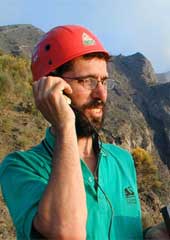The unseen side of MercuryLess than half of Mercury was imaged by Mariner 10 during its three fly-bys in 1974–75. This told us that Mercury is a heavily cratered world, with terrain of a variety of ages including signs of past volcanic activity. It also discovered a magnetic field. Subsequently, Earth-based observations have revealed a deficiency of iron-bearing minerals on the surface (surprising in view of Mercury’s high density) and evidence that its core is partly liquid.
In January, NASA’s MESSENGER probe made the first of three scheduled fly-bys of Mercury, imaging much of the hitherto unseen side of the planet. If all goes to plan, it will enter orbit around the planet in 2011. In this talk I will describe why Mercury is an important target in the context of Solar System exploration, and discuss some of the new images and results from the MESSENGER fly-by. I will look ahead to what we hope to learn when MESSENGER goes into orbit around Mercury, and from the more sophisticated European–Japanese BepiColombo mission that is due to arrive in 2019.
About David Rothery
Dr David Rothery spent his boyhood as a keen member of the Birmingham Astronomical Society, and later became chairman of the Cambridge University Astronomical Society before taking up a career as a geologist. He is based in the Open University’s Department of Earth and Environmental Sciences, where he chairs courses in planetary science and volcanology. Much of his research has been based around using satellites to monitor and measure terrestrial volcanic activity. He is the UK Lead Scientist on the Mercury Imaging X-ray Spectrometer (MIXS) that will fly to Mercury on BepiColombo.
Site design by Concept Graphics
